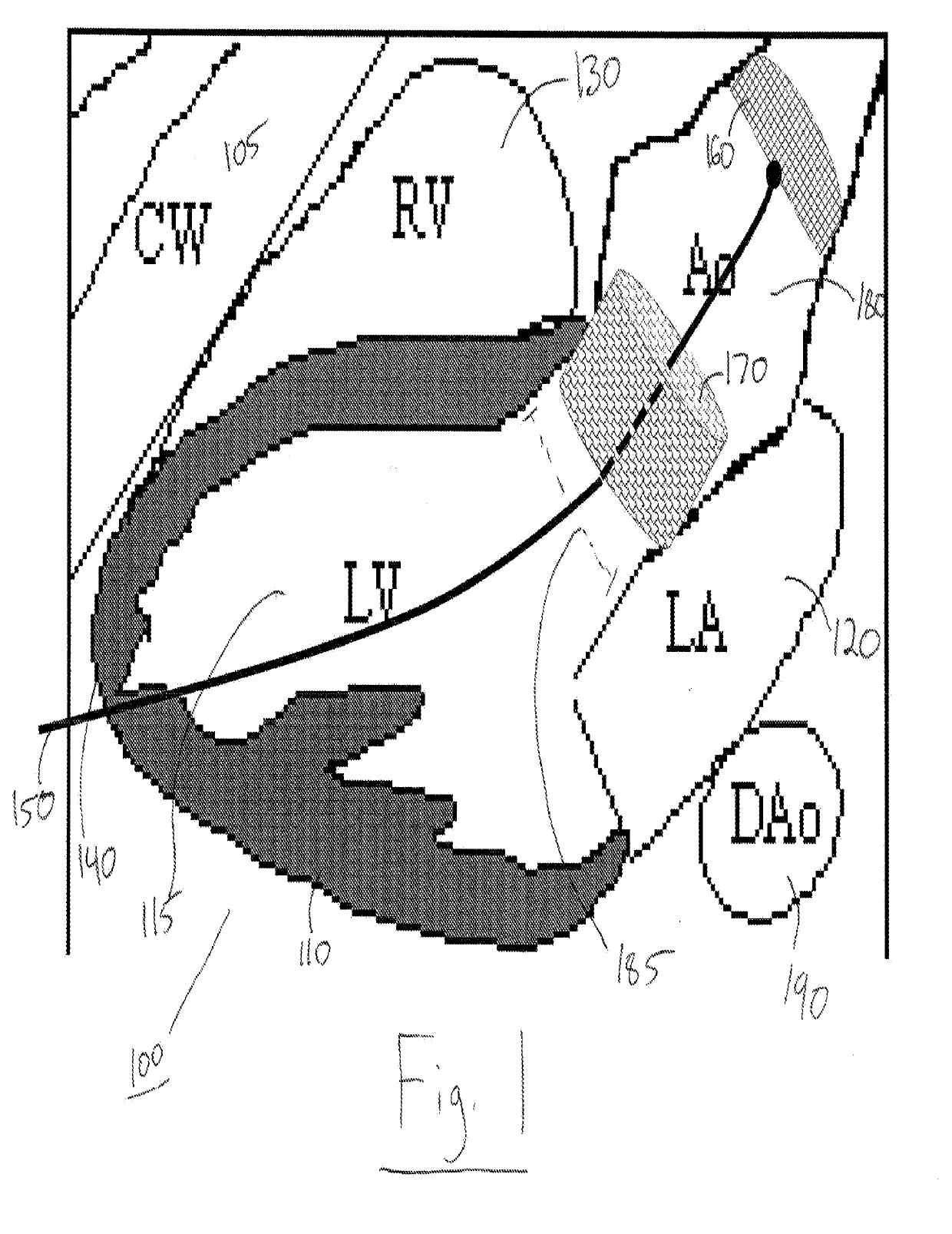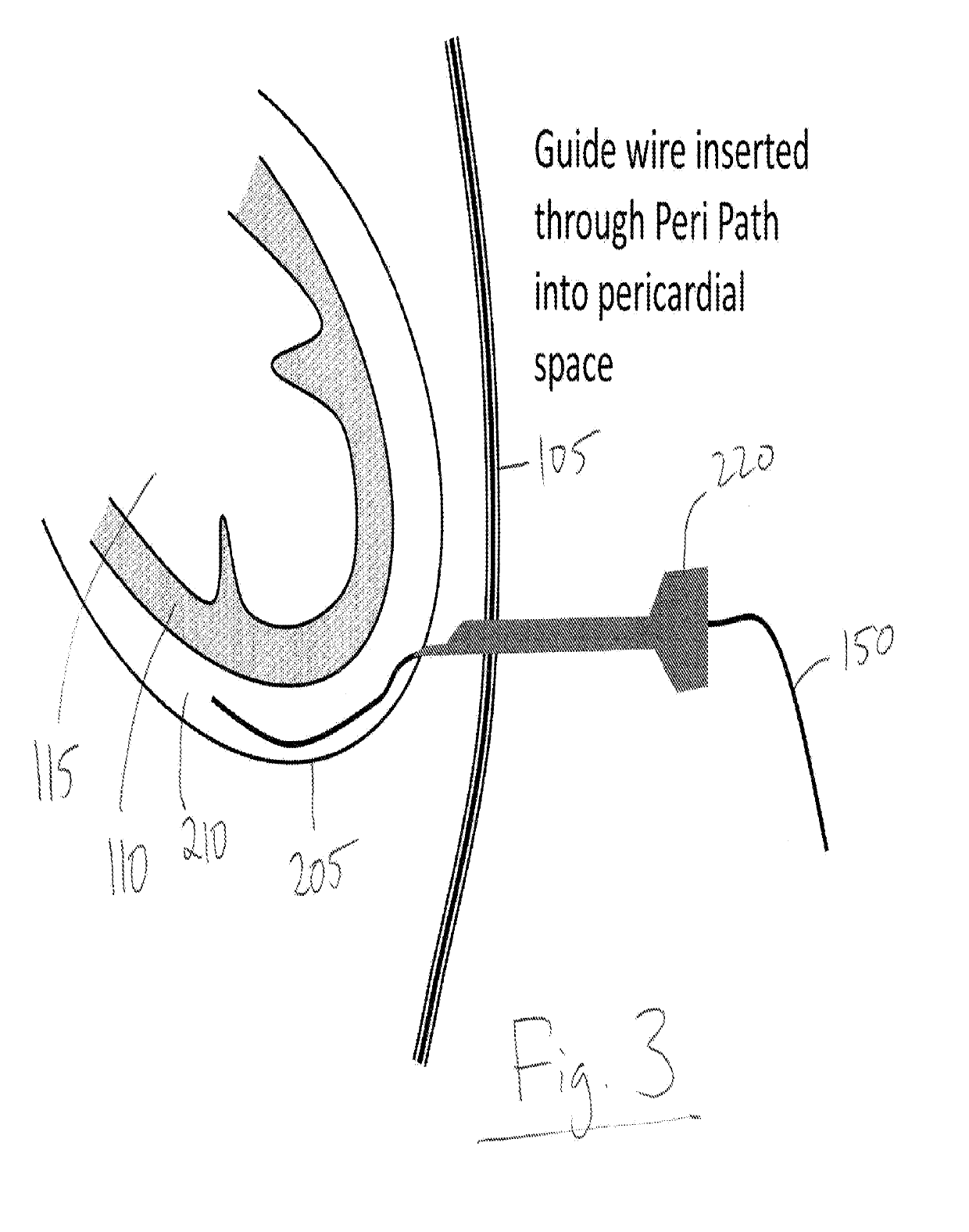[0007]A trans-apical approach according to the present invention will avoid those issues and these of prior art techniques and apparatus but may require mini-surgery that is minimally invasive, but on the other hand, requires considerable operating room time, Both femoral and apical or atrial approaches may use separate intra-procedure ultrasound (or other) imaging, A trans-apical system that does not need surgery, prevents strokes and provides built-in imaging, and intra-procedure monitoring will allow safe and reliable deployment of cardiac valves and significantly expand the use of these transcatheter valves.
[0011]Once the pericardial space has been penetrated via the sheath, the guide wire may be removed leaving the sheath displaced at an angle (a sharp angle less than ninety degrees) and entering the pericardial space. The operating space between the outer and inner pericardial linings may be expanded by injecting saline or other solution to create an operating space volume using a hollow needle moved through the sheath, Through the sheath and with ultrasound guidance, a periport (pericardial space portal) now comprising an assembly of a particulate aortic filter (undeployed) followed by a prosthesis comprising a replacement heart valve may be deployed via first and second tubular pushers surrounding a guide wire. To provide ultrasound guidance, an imaging transducer may be moved from a lengthwise position along the periport to a position that is angled, for example, at an angle less than orthogonal with the periport to place the ultrasound imager at a location with a directed imaging zone that captures the heart and subsequent, use of the periport. The ultrasound imager should have sufficient depth to reach within the heart and have sufficient resolution to view heart parts especially the heart valve to be replaced and beyond the valve to where a filter such as an ascending aortic filter may be utilized to prevent stroke demonstrated as problematic in the prior art.
[0012]To achieve the goals of depth of ultrasound vision, the ultrasound transducer may be calibrated within a range of twenty-five kHz to 100 MHz and, more, particularly, operate in a range between one and ten MHz. As taught in prior patent applications of the inventor, the image guided catheter may comprise a plurality of imaging lumens in which transducers, sheaths, guide wires, delivery systems and tools may be replaced in real time within a particular lumen under vision. in addition, as discussed above, it is important to prevent leaks from the pressure zone of the heart ventricle by inserting the periport device at an angle once in the pericardial space (which may be opened with saline solution (as discussed above) and its tip bent to point to the ventricular space at an angle at its apex to prevent leakage. Through the bent periport located just outside the ventricular apex, a needle may be introduced so as to puncture the ventricular apex of the heart at a sharp angle to minimize flow of blood from the ventricle into the pericardial space and then the periport may be straightened for continuing the procedure. Then, the periport is advanced through the left Ventricle apex using the needle as a guide wire and at an angle to prevent blood loss. The periport is deployed (moved) into the ventricular space. The needle may then, having served its purpose, be removed by retraction through the periport and out the chest wall.
[0015]Once the prosthesis and replacement valve are in place and positioned to Ell the entire space taken by the defective valve, ultrasound may be used to look for leakage of blood around the prosthetic valve and the valve expanded in size, like a balloon, or change shape from an elongated cylinder to a fat, short cylinder to fill the space entirely that was left by the defective, pushed aside valve. Once the new valve is placed, the aortic filter is collapsed like an umbrella for removal capturing any particulate matter inside, and may be removed by the plastic tube or pusher that now becomes a puller. When pulling the collapsed filter out of the heart, the J-tip collapses, is automatically straightened and so the collapsed filter (like a collapsed umbrella) is easily pulled out through the prosthetic valve along with the, for example, J-tipped guide wire.
[0016]The heart valve prosthesis is now capable of functioning normally replacing the defective valve. Remaining still, at the ventricular apex is the periport which is now used for delivery’ of a closure device comprising two umbrella-like pads, a distal pad and a proximal pad for closing the myocardium, for example, at the ventricular apex. The closure device then comprises a distal pad a proximal pad and wires used for installation, control of opening and closing and, in particular, closing the angled hole remaining at the ventricular apex of the myocardium, The distal pad is pushed through the myocardial opening, opened and then pulled to a position closing about the myocardial angled opening. Then, the proximal pad is opened and is pushed upward until it reaches the myocardium under ultrasound vision. The two reverse, open “umbrella” pads, the distal and proximate pads, effectively close the angled myocardium entry point so as to preclude any release of blood through the ventricular apex.
 Login to View More
Login to View More  Login to View More
Login to View More 


